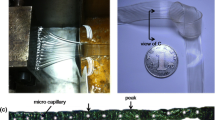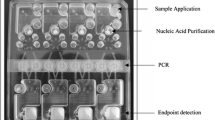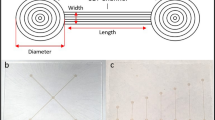Abstract
Microfluidic applications demand accurate control and measurement of small fluid flows and volumes, and the majority of approaches found in the literature involve materials and fabrication methods not suitable for a monolithic integration of different microcomponents needed to make a complex Lab-on-a-Chip (LoC) system. The present work leads to a design and manufacturing approach for problem-free monolithic integration of components on thermoplastics, allowing the production of excellent quality devices either as stand-alone components or combined in a complex structures. In particular, a polymeric liquid flow controlling system (LFCS) at microscale is presented, which is composed of a pneumatic microvalve and an on-chip microflow sensor. It enables flow regulation between 30 and 230 μl/min with excellent reproducibility and accuracy (error lower than 5%). The device is made of a single Cyclic Olefin Polymer (COP) piece, where the channels and cavities are hot-embossed, sealed with a single COP membrane by solvent bonding and metalized, after sealing, to render a fully functional microfluidic control system that features on-chip flow sensing. In contrast with commercially available flow control systems, the device can be used for high-quality flow modulation in disposable LoC devices, since the microfluidic chip is low cost and replaceable from the external electronic and pneumatic actuators box. Functionality of the LFCS is tested by connecting it to a microfluidic droplet generator, rendering highly stable flow rates and allowing generation of monodisperse droplets over a wide range of flow rates. The results indicate the successful performance of the LFCS with significant improvements over existing LFCS devices, facing the possibility of using the system for biological applications such as generating distinct perfusion modes in cell culture, novel digital microfluidics. Moreover, the integration capabilities and the reproducible fabrication method enable straightforward transition from prototype to product in a way that is lean, cost-effective and with reduced risk.









Similar content being viewed by others
References
Bertholle F, Velvé Casquillas G Digital microfluidics using pressure driven flow [Online]. Available: http://www.elveflow.com/microfluidic/Microfluidic%20droplets%20with%20elveflow%20pressure%20driven%20flow.pdf
Choi JW, Kang DK, Park H, deMello AJ, Chang SI (2012) High-throughput analysis of protein-protein interactions in picoliter-volume droplets using fluorescence polarization (in eng). Anal Chem 84(8):3849–3854
Etxebarria Elezgarai J (2015) Modular integration and on-chip sensing approaches for tunable fluid control polymer microdevices. Ph.D., Chemical Engineering and Environmental Engineering, UPV/EHU University of Basque Country
Etxebarria J, Berganzo J, Elizalde J, Fernandez LJ, Ezkerra A (2014) Highly integrated COP monolithic membrane microvalves by robusthot embossing. Sens Actuators B Chem 190:451–458
Etxebarria J, Berganzo J, Elizalde J, Llamazares G, Fernandez LJ, Ezkerra A (2016) Low cost polymeric on-chip flow sensor with nanoliter resolution. Sens Actuators B Chem 235:188–196
Kohl M, Liu Y, Dittmann D (2004) A polymer-based microfluidic controller. In: 17th IEEE Internat. Conf. on micro electro mechanical systems, Maastricht, NL, Technical Digest New York, N.Y, 25–29 Jan 2004
Lammerink TSJ, Elwenspoek M, Fluitman JHJ (1993) Integrated micro-liquid dosing system. In: Proceedings of IEEE-MEMS workshop, pp 254–9
Pollack MG, Shenderov AD, Fair RB (2002) Electrowetting-based actuation of droplets for integrated microfluidics. Lab Chip 2:96–101
Teh SY, Lin R, Hung LH, Lee AP (2008) Droplet microfluidics. Lab Chip 8:198–220
Utada AS, Lorenceau E, Link DR, Kaplan PD, Stone HA, Weitz DA (2005) Monodisperse double emulsions generated from a microcapillary device. Science 308:537–541
Xie J, Shih J, Tai YC (2003) Integrated surface-micromachined mass flow controller. In: IEEE sixteenth annual international conference on micro electro mechanical systems
Xu W, Wu LL, Zhang Y, Xue H, Li GP, Bachman M (2010) A vapor based microfluidic flow regulator. Sens Actuators B Chem 142:355–361
Zeng W, Li S, Wang Z (2015) Characterization of syringe-pump-driven versus pressure-driven microfluidic flows. Presented at the international conference on fluid power and mechatronics
Acknowledgements
This work has been funded by the microSCALE ETORTEK Programme of the Basque Government. The authors would like to acknowledge Mikel Gómez, Javier Aduaga and Javier Besteiro from IK4-IKERLAN S. Coop. and Dr. Roald Tiggelaar from MESA+ Institute for nanotechnology for technical support.
Author information
Authors and Affiliations
Corresponding author
Rights and permissions
About this article
Cite this article
Etxebarria, J., Berganzo, J., Brivio, M. et al. Highly integrated polymeric microliquid flow controller for droplet microfluidics. Microfluid Nanofluid 21, 63 (2017). https://doi.org/10.1007/s10404-017-1898-3
Received:
Accepted:
Published:
DOI: https://doi.org/10.1007/s10404-017-1898-3




